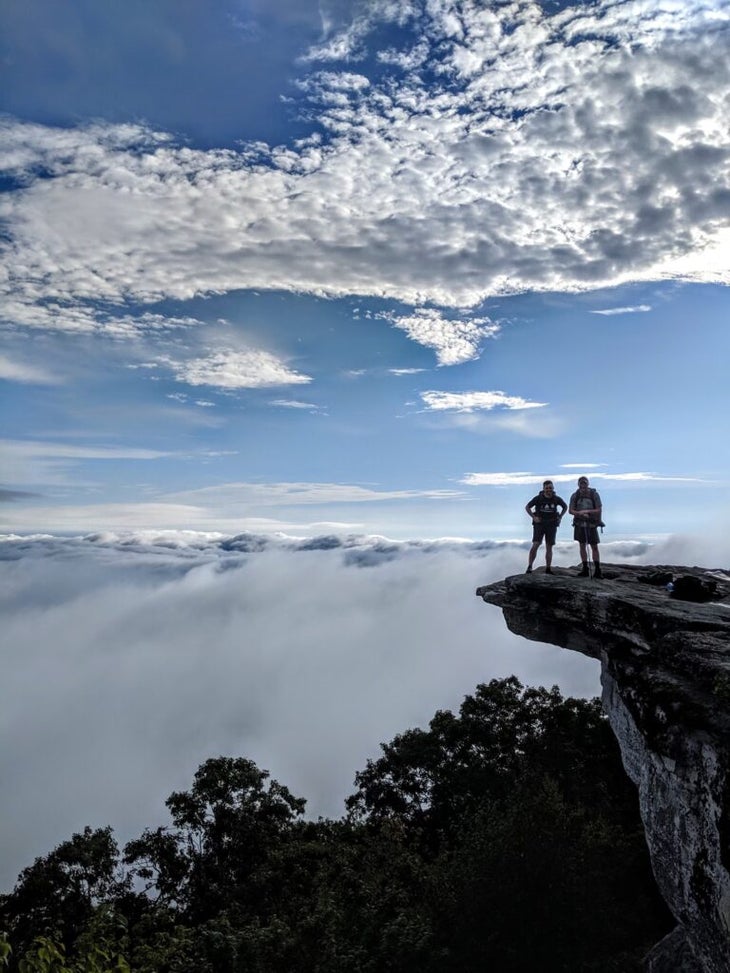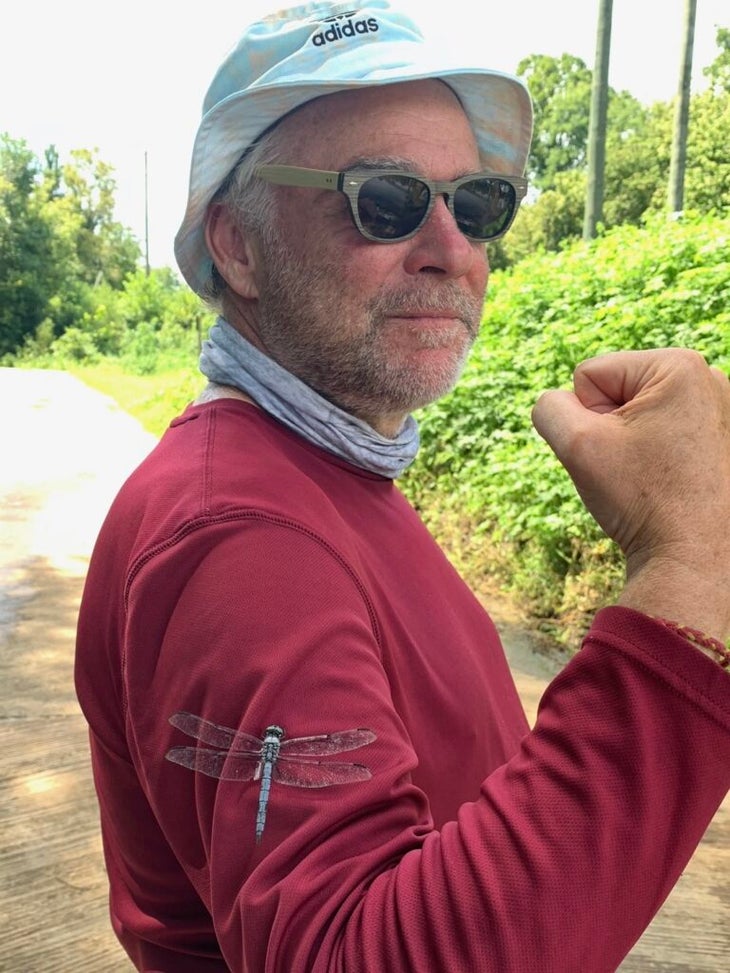Heading out the door? Read this article on the new Outside+ app available now on iOS devices for members! Download the app.
U.S. Senator Tim Kaine leaned into his trekking poles and trudged south up a rocky ridgeline section of the Appalachian Trail deep in Virginia’s 200,000-acre Mount Rogers National Recreation Area. A cold drizzle had been falling on-and-off all day. He wore muddy boots, a tightly hooded rain jacket, and backpack loaded with about 30 pounds of solo camping gear. The wind rose and fog whirled by like a stampede of ghostly tumbleweeds on either side of the 5,300-foot bald. Wild ponies appeared and disappeared like phantoms. He hadn’t seen another soul all day.
“It was remarkably beautiful, but also eerie,” Kaine, now 66, said. The trek was part of the first leg of an epic, three-year tour of his home state of Virginia’s most iconic outdoors experiences in celebration of his 60th birthday and a remarkable 25-year ladder-climb of public service that’s included roles as a city councilor, mayor, governor, Democratic National Committee chairman, two-term senator, and 2016 running mate to democratic presidential candidate Hillary Clinton. Between 2019 and 2021, Kaine thru-hiked 559 miles of the Appalachian Trail, paddled the James River’s entire 348 miles, and cycled 321 miles of the Blue Ridge Parkway and Skyline Drive—all while serving in the Senate.
Kaine calls the somber tableau near Mt. Rogers a turning point. It inspired a brooding contemplation and, after more than two years of bottling up his emotions around the loss of the 2016 election, he allowed his thoughts to run free. It was October of 2019, and Congress was preparing to impeach then-President Donald Trump for the first time. Kaine realized he’d soon be a judge in a high-stakes Senate impeachment trial. He considered the 2016 presidential election, plus everything that had happened since, and asked himself: What does all of this mean for our country?
“I didn’t set out intending to use my time in nature to reflect on the historical moment, its fraught political divisiveness, or the state of our democracy,” Kaine said. But the immersion proved vital during a time of unprecedented political upheaval. He needed it to “spiritually and physically recharge, to take a step back, reflect, and try to gain perspective about what was the best course of action to take and where to focus my energy when I returned to the senate.”
Kaine later parlayed the trips into a book that would launch a branded, statewide adventure triathlon—he published Walk, Ride, Paddle: A Life Outside earlier this year. Kaine’s account serves as a deep meditation on the value of nature and nature experiences, and offers a window into the mind of one of the United States’ most influential lawmakers grappling with the police killing of George Floyd, national racial justice protests, a global pandemic, the contested 2020 election, the Capitol insurrection, and more.
“When I planned these trips, I had no idea this series of extraordinary events was going to happen,” Kaine said. But as the next three years descended into an ever-darkening political rabbit hole, he was glad to have the journeys to look forward to. They served as galvanizing respites between high-stakes government sessions that felt increasingly like something plucked from the British TV series, “Black Mirror.”

Kaine had dreamed of taking trips like these for decades, but being a father of three with a demanding career made immersive off-the-grid adventures impossible. He made do by taking frequent section hikes, cycling, or going on canoeing trips with family and friends on weekends or during vacations.
“My love for the natural world and outdoor recreation began pretty early on,” he said. “It’s since been one of the most important and resounding themes in my life.”
It started with an elementary school Boy Scout troop in his hometown of Kansas City. “By all measures, I wasn’t a very good scout,” Kaine said. He didn’t try very hard to earn badges and often skipped meetings. Still, a weekend winter camping trip on a farm around age 12 blew his mind. “There was something magical about sleeping in a tent under the stars and cooking over a fire,” he said. “I was hooked.”
Kaine’s burgeoning interest soon got a boost from an outdoors-loving 7th grade shop teacher.
“He’d tell us about trips he’d taken and sometimes ask if anyone wanted to come along,” said Kaine, who never missed an opportunity to attend. “He and another teacher would load up their cars on Friday and take whomever wanted to go. It was a blast.”
Kaine’s enthusiasm convinced his parents and two brothers to try camping as well. The activity—later often combined with hiking and canoeing—became a cherished family pastime.
In college and law school, Kaine began long-distance backpacking, rock climbing, caving, cycling, and embarking on overnight canoe trips. Of his tenure at Harvard Law School, he joked: “I may not have been on law review, but I set the record for most time spent camping.” That’s also where he met classmate and future wife, Anne, whose passion for the outdoors rivaled his own.
“She was from Virginia and introduced me to its incredible bounty of natural beauty,” said Kaine. He’d planned to practice law in Kansas City, but was swayed toward Richmond for its proximity to the James River and Blue Ridge Mountains. “If you love the outdoors, you can’t beat Virginia,” said Kaine. “As a young couple and then later with kids, we hiked, camped, canoed, bicycled, and backpacked all over the state.”

Through the years, Kaine developed a penchant for commemorating milestones. His 25th anniversary of elected public service coinciding with a 60th birthday felt huge. He wanted to mark the occasion, but how?
A conversation with in-laws about New York’s Adirondack 46er sparked an idea. The popular quest challenges participants to summit all of the state’s 4,000-plus-foot peaks and is a major life goal for many local hikers. Kaine wondered if he could do something similar for the Old Dominion epics he knew and loved. A branded “Virginia Adventure Triathlon” combining the Blue Ridge Parkway, Appalachian Trail, and James River immediately came to mind.
These were bucket list trips for him and it struck him that writing a book would provide the perfect excuse to finally take them on.
“I thought, ‘If I can use my personal experience and passion to [shine] a light on these amazing assets and maybe establish something new in the process?’” said Kaine. “Now that’s a worthy undertaking and a really valid reason to do this.”
Next came logistics. Kaine used a novel approach to senate recesses to pack the ambitious journeys into an overwhelmingly busy schedule. During a normal year, a three-month fall recess is intended to give senators time to travel to meet with home state constituents, attend events, give talks, tour facilities, and so on.
“I’d do that, but without an RV, car, or plane, and in a much less formal or scripted way,” said Kaine. “I thought, ‘Why not tour by foot, bike, and canoe, stopping in communities and visiting with people to hear about what matters to them along the way?”
He threw himself into planning and broke out his fleet of well-worn trail maps and guidebooks. Kaine delighted in calculating things like mileage between projected stops at shelters, hostels, campgrounds, or inns, the amount of rations he’d need for a given section, and where to buy beer or mail care packages. He assessed old gear, researched new items, and compiled a cache.
“I felt like a kid in a candy store,” Kaine said. “I was so excited that I was finally going to get to do this.”
That’s not to say the treks didn’t bring significant challenges. Kaine tackled one segment of the triathlon per senate recess over the course of three successive years. He started with the AT hike, thinking it would be better to take on what he viewed as the toughest leg first.
“Three or four days into the hike I started seriously questioning if I could pull it off,” Kaine said. He hadn’t done any serious backpacking in about six years and, while he’d trained to get in shape, the toll on his body was much worse than anticipated. A series of hard rains and thunderstorms also didn’t help. Rest alleviated his doubts, but they often returned toward the end of a hard day of hiking. “It wasn’t until probably day 30 of 45 that I felt for sure I was going to finish,” Kaine said with a laugh.

The James River’s final hundred miles also presented hurdles. Kaine had tons of experience paddling its upper sections in mountainous areas above the fall line. But he’d never floated the flat, mile-plus-wide span of water that flowed through the coastal plain of Virginia from Richmond to the Chesapeake Bay. He knew nothing about maritime traffic patterns, tidal flows, what to expect in terms of progress, where to take out, camp, or book shuttles—and largely decided to wing it.
Still, “it was a wonderful adventure,” he said. Tough, yes. But he cherished every moment—“even when I was physically miserable and exhausted”—because he knew this was “something once in a lifetime.”
Looking back on the experiences, Kaine hopes Walk, Ride, Paddle, which was released this past April, will inspire readers to explore and cultivate a greater appreciation for wild spaces in Virginia and beyond. He’s long been a staunch supporter of public lands and environmental protections (as governor, he enacted Virginia’s first comprehensive clean energy plan and invested more than $1 billion into cleaning up waterways and the Chesapeake Bay), but Kaine said the quest galvanized his passion and has inspired him to “prioritize these issues moving forward.” He’s already working with the Appalachian Trail Conservancy on a centennial bill and is leading an effort to designate Virginia and North Carolina’s 113,000-acre Great Dismal Swamp as a National Heritage Area.
“All kinds of pressures are threatening our natural beauty in Virginia and elsewhere: climate change, accelerating development, deforestation, interstate pipelines, diminishing air and water quality,” Kaine writes in Walk, Ride, Paddle. “I have battled for open space preservation, Chesapeake Bay cleanup, resilience against rising sea levels. But the threat levels are escalating. By getting in touch with our natural beauty, I hope to be a better advocate for new ideas to ensure that our environmental bounty is available for coming generations.”
From 2024
